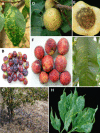Plum pox virus and sharka: a model potyvirus and a major disease
- PMID: 24102673
- PMCID: PMC6638681
- DOI: 10.1111/mpp.12083
Plum pox virus and sharka: a model potyvirus and a major disease
Abstract
Taxonomic relationships: Plum pox virus (PPV) is a member of the genus Potyvirus in the family Potyviridae. PPV diversity is structured into at least eight monophyletic strains.
Geographical distribution: First discovered in Bulgaria, PPV is nowadays present in most of continental Europe (with an endemic status in many central and southern European countries) and has progressively spread to many countries on other continents.
Genomic structure: Typical of potyviruses, the PPV genome is a positive-sense single-stranded RNA (ssRNA), with a protein linked to its 5' end and a 3'-terminal poly A tail. It is encapsidated by a single type of capsid protein (CP) in flexuous rod particles and is translated into a large polyprotein which is proteolytically processed in at least 10 final products: P1, HCPro, P3, 6K1, CI, 6K2, VPg, NIapro, NIb and CP. In addition, P3N-PIPO is predicted to be produced by a translational frameshift.
Pathogenicity features: PPV causes sharka, the most damaging viral disease of stone fruit trees. It also infects wild and ornamental Prunus trees and has a large experimental host range in herbaceous species. PPV spreads over long distances by uncontrolled movement of plant material, and many species of aphid transmit the virus locally in a nonpersistent manner.
Sources of resistance: A few natural sources of resistance to PPV have been found so far in Prunus species, which are being used in classical breeding programmes. Different genetic engineering approaches are being used to generate resistance to PPV, and a transgenic plum, 'HoneySweet', transformed with the viral CP gene, has demonstrated high resistance to PPV in field tests in several countries and has obtained regulatory approval in the USA.
© 2013 BSPP AND JOHN WILEY & SONS LTD.
Figures



References
-
- Adams, M.J. , Zerbini, F.M. , French, R. , Rabenstein, F. , Stenger, D.C. and Valkonen, J.P.T. (2012) Family Potyviridae In: Virus Taxonomy (King A.M.Q., Adams M.J., Carstens E.B. and Lefkowitz E.J., eds), pp. 1069–1090. San Diego: Elsevier.
-
- Anindya, R. , Chittori, S. and Savithri, H.S. (2005) Tyrosine 66 of Pepper vein banding virus genome‐linked protein is uridylylated by RNA‐dependent RNA polymerase. Virology, 336, 154–162. - PubMed
-
- Atanasoff, D. (1932) Plum pox. A new virus disease. Annals of the University of Sofia, Faculty of Agriculture and Silviculture 11, 49–69.
-
- Badenes, M.L. and Llácer, G. (2006) Breeding for resistance: breeding for Plum pox virus resistant apricots (Prunus armeniaca L.) in Spain. EPPO Bull. 36, 323–326.
Publication types
MeSH terms
Associated data
- Actions
- Actions
- Actions
- Actions
- Actions
- Actions
- Actions
- Actions
LinkOut - more resources
Full Text Sources
Other Literature Sources
Research Materials
Miscellaneous

